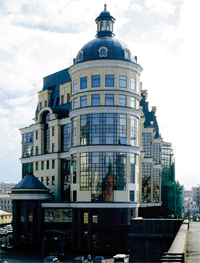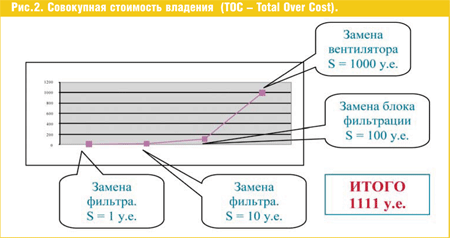Все про видеонаблюдение
Все про умный дом
Все о пожарной безопасности
Сейчас читают
 Как ускорить и смотреть ютуб без тормозов и замедленияЕсли Вы на этой странице, то Вам, скорее всего, […]
Как ускорить и смотреть ютуб без тормозов и замедленияЕсли Вы на этой странице, то Вам, скорее всего, […] 10 лучших прогрессивных языков программирования для разработки мобильных приложенийЗнаете ли вы, что мобильные приложения — это не только […]
10 лучших прогрессивных языков программирования для разработки мобильных приложенийЗнаете ли вы, что мобильные приложения — это не только […] 6 важных особенностей, которые следует учитывать при строительстве нового домаСтроительство нового дома – это уникальная возможность […]
6 важных особенностей, которые следует учитывать при строительстве нового домаСтроительство нового дома – это уникальная возможность […]
Гороскоп на Сегодня

The basis for managing the enterprise's engineering systems.
Such a large-scale reconstruction was necessary due to the high probability of failure of the buildings' life support systems, as well as the operation of outdated equipment.
Only by ensuring the uninterrupted operation of engineering systems can the continuity of the bank's business processes as a whole be guaranteed.
It is unnecessary to explain how critical a failure in the operation of the country's main bank can be for the entire financial system of the country. A minute of downtime in the electronic payment system results in millions in losses. In addition, the continuity of such processes as: communication with the exchange, account servicing, making payments, etc., implies work 24 hours a day, 365 days a year. Such a mode requires qualitatively different approaches to organizing the uninterrupted and trouble-free operation of facilities. To solve the problem, the following solution was developed, called the Unified Dispatch Center (UDC).
Prerequisites for the creation of the UDC concept
Since 1994, the company «CHERUS» has been carrying out a range of works on designing and implementing engineering support systems in the central office of the Bank of Russia, as well as a number of its divisions. The complex of engineering support systems for the facilities included power supply systems, ventilation systems, air conditioning (including technological), and fire protection systems.
Engineering systems, in principle, require highly qualified service, and such service that would correspond to the level of the installed equipment was not available at the Central Bank, and especially not at other banks.
Initially, neither the Central Bank management nor we planned to automate engineering systems, but as the work progressed, it became obvious that a unified system for monitoring and managing the entire engineering complex was needed. Firstly, any equipment can fail, and therefore, it will take time to restore it.
In addition, it is necessary not only to reduce the response time to incidents that arise, but also to be able to prevent failures and malfunctions in the operation of systems, always know what is happening with the equipment at the facility and receive proactive messages.
Previously, the situation was as follows: the response occurred only after a series of calls from the facility or, even worse, calls were received after a series of incompetent actions by the service personnel, which subsequently led to serious problems with the equipment.
The second important prerequisite for implementing the monitoring system is the impossibility of assigning a corresponding specialist to each type of equipment: it is physically impossible to ensure the presence of a highly qualified electrician, air conditioner technician or other service employee in each of the 1,200 branches of the Central Bank, especially if these facilities are located in remote areas of the country.
After conducting a comprehensive analysis, it was decided to begin work on creating a monitoring system with the power supply system, since this is the most critical life support system for facilities, and the most technically complex equipment in this system is the UPS (uninterruptible power supply).
Very often, UPS maintenance or diesel generator maintenance is transferred to the company that installed them, i.e.
the company that supplies these devices also services them. However, such dependence on external contractors reduces the reliability of the system and is not always feasible at remote sites.
So, the first stage of developing a unified system was the creation of a system for monitoring and controlling the operation of all uninterruptible power supplies.
After some time, the specialists working on the project realized that the task was much broader and more complex than initially imagined. Firstly, it was necessary to control not only the power supply system, but also the entire engineering complex. Secondly, it became clear that it was impossible to ensure uninterrupted operation of engineering systems using software alone (even using the most powerful SCADA systems). To ensure reliable and trouble-free operation of the facilities, it was necessary to develop a set of organizational and technical measures. The solution came in the creation of a Unified Dispatch Center (UDC). Its main task is to control and manage the entire complex of engineering systems of a large geographically distributed company in order to ensure stable and trouble-free operation. Looking a little ahead, we will say that the UDC is also an effective tool for reducing operating costs of companies.
Solution architecture
The EDC model created by our company's specialists consists of three interconnected components:
• electronic passport of the facility,
• monitoring system,
• call processing center (or call center).
Each component performs its own function and ensures the solution of certain system tasks.
The electronic passport is a comprehensive description of the facility and contains all the information related to the life cycle of the equipment and necessary for its maintenance and repair (see Fig. 1).

In order to create an electronic passport for the entire facility, it is necessary to conduct a full inventory of the equipment located on it. This applies not only to complex technical equipment, but also to any parts that were purchased, right down to spare filters, belts, etc. The components of the equipment — filters, fans, etc. — are also subject to inventory and are included in the electronic passport of the product and the entire facility.
The electronic passport allows the company's operational services to keep records of equipment and have a complete picture of what is on their balance sheet. It can also be used to quickly obtain information about which service contracts correspond to a particular installed equipment, what maintenance work has been carried out or is planned to be carried out. The electronic passport can include information about the cost of predicted repairs. This makes it possible to compare the cost of servicing current equipment and purchasing new equipment. As a result, it is much easier to decide whether it is worth continuing to service the equipment or whether it is time to replace it.
Thus, the electronic passport allows you to keep track of the total cost of ownership (Total Over Cost) and all costs associated with the life cycle of the equipment in real time. An example of calculating the total cost of ownership is shown in Fig. 2.

But let's get back to inventory. Today, there are three ways to conduct an inventory of equipment:
• the most common and least effective method is the classic application of an inventory number to objects with a marker, paint, etc.;
• the second is bar coding;
• the third, most “advanced” method is radio frequency identification (RFID).
RFID and barcoding technologies are very similar — the difference is that in the case of RFID, it is not the barcode that is read, but the radio frequency signal. This method of inventory is very convenient if the equipment or system is located in a hard-to-reach place (for example, behind a wall, behind the ceiling, etc.).
In addition, the barcode is extremely sensitive to environmental influences (humidity, temperature, sunlight, etc.), wears out over time and may lose the ability to be read. The RFID method is the most reliable and durable, not sensitive to environmental factors. In addition, to read an RFID tag, it is enough to be in the range of its radio frequencies (from 5 cm to several meters). In this case, the object does not necessarily have to be in the line of sight.
This advantage is especially important when it is necessary to conduct not an initial inventory at the facility, but its repeated audit.
As a result of the inventory, all data (no matter which of the three methods they were identified) are entered into an information base, in which each inventory number corresponds to the name of the product, its location, information about the specialist or company that services it, the cost of maintenance and repair, etc. An important feature of the EDC is that all information systems and the Call Center are integrated into a single information space.
The monitoring system is the second component of the EDC. It records information about the state of the facility and equipment and presents it in a form convenient for the operator.
The main functionality of the system is control and monitoring of the operation of all engineering systems located at the facilities.
For the monitoring system of the Central Bank of the Russian Federation, the software department of «CHERUS» developed its own software product «CHERUS-macro system» (monitoring and control of remote object systems). In essence, this is a BMS (building management system) class system, and, of course, this solution has analogues on the market. Any other SCADA system, combined with a maintenance and repair system, which is part of the electronic equipment passport and related to maintenance and repair, can act as a monitoring system.
Like any control and management system, the monitoring system has a classic three-level structure. The first-level elements are located directly on the object and are sensors built into the engineering equipment. They record the equipment operating parameters (voltage, temperature, etc.) and transmit them to the controller, which can be installed at each object, or control the operation of several objects located fairly close to each other.
The controller converts the information received from the sensors into digital form and transmits it to the control center, which can be located at any remote point (for example, in the central office). Here it is displayed on the operator's monitor screen in the format familiar to him (graphs, electrical diagrams, etc.). The system can be configured so that, in the event of critical messages, the information is duplicated on the phone, pager, laptop of several responsible persons. Communication between the controller and the EDC can be carried out in various ways: via the Internet, via optical cable, via radio channel, satellite communication or any other existing method. It can be specially protected and encrypted. Thus, the control center, located in Moscow, controls the operation of all the enterprise's facilities.
If, for example, a failure occurs in the operation of the air conditioning supply unit, this information is transmitted to the information processing point, which is a complex of software and hardware (sensors — controller — computer). Then the system classifies the incident category, identifies the event and issues a schedule of necessary repair work, and, if necessary, an invoice for the work. In addition, the processing (monitoring) unit works not only with current failures, but also with planned maintenance, and also issues a schedule and an invoice for planned work. Thus, the monitoring system performs the task of registering and transmitting information about the state of engineering systems at facilities to the accounting system.
The current state of engineering systems is displayed on-line on the monitor screen in a familiar and convenient form for the operator. In the event of an incident, information about it is automatically transferred to the accounting system, which contains a list of possible failures, work regulations and estimates for their elimination. Thus, for some failure in the same supply ventilation system, the system signals a malfunction, identifies the nature of the malfunction, issues regulations and an estimate of the work.
In addition to the monitoring system that records information about failures, the EDC model includes a Call Center. It is a single entry point for all problems related to the state of engineering systems. The center operators accept requests directly from operating services and tenants, coordinate the fulfillment of requests for maintenance and support of infrastructure elements.
The main tasks of the Call Center are the operational management of equipment failures and the organization of the work of service departments.
System Reliability
All EDC components ensure the reliability of the system:
1. Thanks to the electronic passport of the facility, it becomes possible to perform scheduled equipment repairs and timely replacement of parts, which significantly reduces the risk of problematic situations.
2. The monitoring system sends proactive messages about failures or changes in the operating parameters of the system, which allows you to promptly respond to a problematic situation and resolve it with the help of a qualified specialist.
3. The monitoring system allows you to predict failures. By recording the repetition of any failure in the operation of the equipment, it signals a system error. A specialist monitoring the correct operation of the engineering system, using the data received, has the opportunity to contact the service department of the company servicing this equipment before a serious failure occurs, such as, for example, a failure of the uninterruptible power supply.
4. Integration of all information systems and the Call Center allows for quick and professional troubleshooting of equipment failures. Since the monitoring system itself is not immune to failures, as it consists of various equipment, it is designed in such a way that, with a professional approach to troubleshooting, the time for full restoration of its functionality does not exceed 30 minutes. This condition is specified in the Technical Assignment.
Results
To date, the Central Bank of the Russian Federation has implemented most of the EDC concept.
The central office of the bank, located in Moscow, has implemented the SBGE monitoring system.
The number of subsystems of this power supply system is in the hundreds.
It is worth noting that there is no shortage of offers for monitoring systems on the market, but the fundamental difference of the EDC is that it offers a set of technical and organizational measures that, taken together, ensure trouble-free operation of facilities.
The system is focused on the fact that it is possible to make the right balanced decisions only by creating a single information space, a single point for processing all information and a single decision-making center.






Добавить комментарий